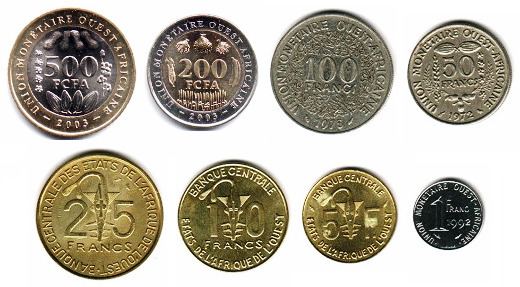Code XOF Exponent 0 Symbol CFA | Number 952 1/100 centime centime c | |
 | ||
The West African CFA franc (French: franc CFA; Portuguese: franco CFA or simply franc, ISO 4217 code: XOF) is the currency of eight independent states in West Africa: Benin, Burkina Faso, Guinea-Bissau, Ivory Coast, Mali, Niger, Senegal and Togo. These eight countries have a combined population of 105.7 million people (as of 2014), and a combined GDP of US$78.4 billion (as of 2012).
Contents
The acronym CFA stands for Communauté Financière d'Afrique ("Financial Community of Africa") or Communauté Financière Africaine ("African Financial Community"). The currency is issued by the BCEAO (Banque Centrale des États de l'Afrique de l'Ouest, "Central Bank of the West African States"), located in Dakar, Senegal, for the members of the UEMOA (Union Économique et Monétaire Ouest Africaine, "West African Economic and Monetary Union"). The franc is nominally subdivided into 100 centimes but no centime denominations have been issued.
The Central African CFA franc is of equal value to the West African CFA franc, and is in circulation in several central African states. They are both the CFA franc.
History
The CFA franc was introduced to the French colonies in West Africa in 1945, replacing the French West African franc. The West African colonies and territories using the CFA franc were Ivory Coast, Dahomey, French Sudan, Mauritania, Niger, Sénégal, Togo and Upper Volta. The currency continued in use when these colonies gained their independence, except in Mali (formerly French Sudan), which replaced at par the CFA franc with its own franc in 1961.
In 1973, Mauritania replaced the CFA franc with the ouguiya at a rate of 1 ouguiya = 5 francs. Mali readopted the CFA franc in 1984, at a rate of 1 CFA franc = 2 Malian francs. The former Portuguese colony of Guinea-Bissau adopted the CFA franc in 1997, replacing the Guinea Bissau peso at a rate of 1 CFA franc = 65 pesos.
Coins
In 1948, aluminium 1- and 2-franc coins were introduced. These were followed in 1956 by aluminium-bronze 5, 10 and 25 francs. All carried the name Afrique Occidentale Française. In 1957, 10- and 25-franc coins were issued with the name of Togo added. From 1959, coins have been issued by the BCEAO.
Nickel 100-franc coins were introduced in 1967, followed by the cupro-nickel 50-franc coins in 1972. Small, steel 1-franc coins were introduced in 1976 (struck until 1995), followed by bimetallic 250 francs in 1992 (struck until 1996). In 2003, bimetallic 200- and 500-franc coins were introduced.
